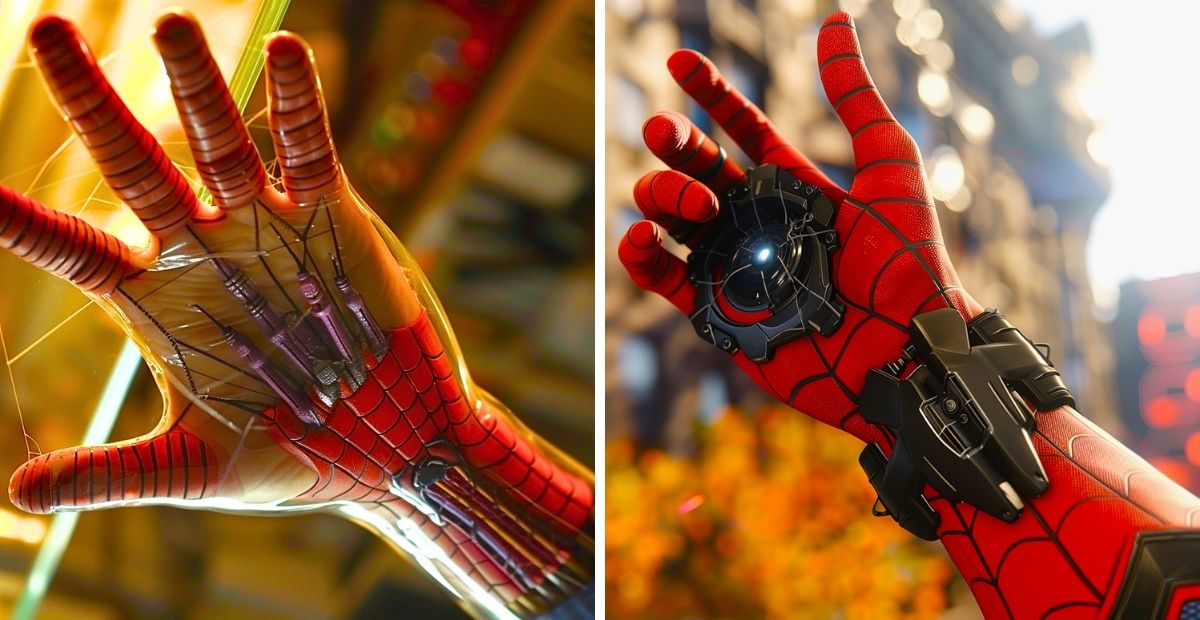Today, we have a mix of films that embrace the original tech web-shooters and others that opt for the organic route.
Each choice brings something unique to the Spider-Man character, whether it’s his ingenious tech side or the seamless, natural web-slinging.
It’s a debate that keeps on giving, offering different shades of Spider-Man for fans to enjoy and discuss.
Contents
The Inner Workings of Spider-Man’s Organic Webs
Spider-Man’s organic web-shooters are a marvel of nature’s engineering, hidden right beneath his wrists.
These are not your garden-variety spider webs; they’re something spiders themselves would envy.
The complex muscle structures within Peter’s forearms, like sphincters near the silk glands, work together to shoot webbing through a duct system with impressive force.
He can control the pressure, flow, and even the texture of the web on the fly—literally!
So how does Spidey get from liquid silk to sturdy webs?
It’s all about the glands, which likely sit snug in his forearms, working overtime to whip up loads of web fluid.
Secretory cells within these glands are busy churning out fibroin proteins, transforming them into silk that’s liquid at first but solidifies upon contact with air.
This enables our hero to create webs of various thickness and stickiness, perfect for any situation, be it ensnaring baddies or swinging between skyscrapers.
Peter’s supercharged metabolism plays a crucial role in keeping his web fluid stocked up.
Just like his increased endurance and agility, his body can produce web fluid rapidly, as long as he’s well-fed.
And the strength? Spider silk is incredibly tough, surpassing steel in tensile strength. Spider-Man’s webs are even stronger, showcasing the power of organic webbing at its best.
The Marvel of Engineering: Tech Web-shooters
Tech web-shooters are not just a cool gadget in Spider-Man’s arsenal; they’re a testament to Peter Parker’s ingenuity and resourcefulness.
Created not for heroics but for stunning stunts, these twin wrist-wonders soon became Spider-Man’s primary tool for justice.
Over the years, despite his tight budget, Peter has fine-tuned these devices with upgrades like a low-fluid indicator, tracer launchers, and even voice commands.
Made from simple materials but with a design that would make million-dollar tech look basic, Peter’s web-shooters are a blend of accessibility and advanced functionality.
At the heart of the web-shooters are the unique spinneret nozzles, handcrafted by Peter to manipulate his web fluid with precision.
Using a powerful turbine and bearings made from durable materials like Teflon, Amber, and Sapphire, these nozzles transform the pressurized fluid into the strong, versatile webbing we see in action.
The triggering system is ingenious – requiring 65 pounds of pressure per square inch to operate, ensuring that only Spider-Man has the strength to use it effectively, preventing any accidental web-slinging mishaps.
The true value of Spider-Man’s tech lies in the web fluid cartridges – a secret formula likely related to nylon, capable of knitting polymer chains into a fiber with impressive adhesive properties.
Despite its incredible tensile strength, the webbing dissolves into a powder after exposure to air for an hour, thanks to specific compounds within.
Economical yet efficient, these cartridges epitomize Spider-Man’s ability to create an endless variety of web-based tools on a budget.
Despite their amazing potential, these web-shooters remain undetected through metal detectors, a testament to Peter’s need for stealth and practicality.
In essence, tech web-shooters are not just tools but a symbol of Spider-Man’s creative and scientific prowess, weaving the impossible into reality with every swing.
Organic vs. Tech Web-shooters
In 1962, Peter Parker showed us his inventor side by crafting mechanical web-shooters, an iconic symbol of his persona.
These gadgets aren’t just a display of Peter’s scientific acumen; they add suspense to his story.
Running out of web fluid? Web-shooters got damaged? These scenarios push our hero to think outside the box and fight creatively.
Plus, who doesn’t love seeing Spider-Man reload his wrist-tech mid-battle?
Fast forward to 2004, and we see Spider-Man undergo a mutation that grants him organic web-slinging abilities.
It’s a nod to the Raimi films and a dramatic shift from tech-based webbing.
No reloads, no tech hiccups—just pure, unlimited web action.
This change, although brief in the comics, sparked a new conversation about Spider-Man’s powers and their source.
However, the organic webs may also run into trouble. Remember that one time Rami Spider-Man suddenly loses all his power when slinging around?
Though he regains the power after that when encounters Doc Ock, the odds are there waiting to happen.
Your Friendly Neighborhood Decision
On one side, we have the organic webbing seen in Sam Raimi’s films—spontaneous and unlimited.
On the other, the mechanical web-shooters highlight Peter Parker’s genius, a hallmark of his character since his comic debut.
Personally, whether it is a self-made web-shooter or the organic, he’s still our beloved Spider-Man, as a fan, I like him either way.
So, what’s your take on Spider-Man’s web-slinging methods?
Let us know in the comment section below!
